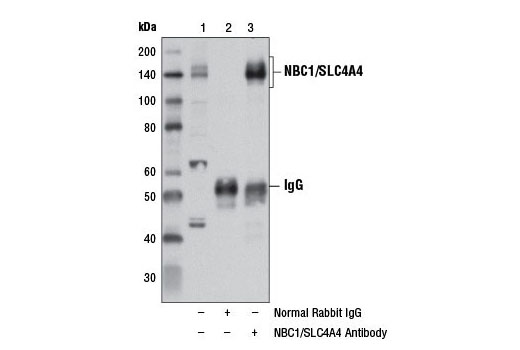WB, IP
H M Mk
Endogenous
135-145
Rabbit
#Q9Y6R1
8671
Product Information
Product Usage Information
| Application | Dilution |
|---|---|
| Western Blotting | 1:1000 |
| Immunoprecipitation | 1:50 |
Storage
Specificity / Sensitivity
Species Reactivity:
Human, Mouse, Monkey
Source / Purification
Polyclonal antibodies are produced by immunizing animals with a synthetic peptide corresponding to residues near the carboxy terminus of human NBC1 protein. Antibodies are purified by protein A and peptide affinity chromatography.
Background
NBC1/SLC4A4 is an eletrogenic sodium bicarbonate cotransporter. It mediates the coupled movement of Na+ and HCO3- ions across the basolateral membrane of cells. NBC1 regulates secretion and absorption of bicarbonate and modulates intracellular pH (1-3). There are five isoforms of NBC1 produced by alternative splicing including the most studied isoforms, 1 and 2, which have different N termini. The N terminus of isoform 1 contains multiple consensus phosphorylation sites for various kinases, such as PKA, PKC, and CK II, and may play a regulatory role in the biological function of NBC1 (4). Interaction with carbonic anhydrase II, IV, and IX regulates the transporter acitivity of NBC1 (5-7). NBC1 is expressed in various tissues with the exception of isoform 2, which is mainly expressed in kidney proximal tubules (1). Isoform 1 is expressed in the pancreas and corneal endothelium, and at low levels in other tissues including heart, skeletal muscle, liver, and prostate (4). Research studies have shown that mutations in the NBC1 gene are linked to proximal renal tubular acidosis with ocular abnormalities (also known as renal tubular acidosis II).
- Burnham, C.E. et al. (1997) J Biol Chem 272, 19111-4.
- Amlal, H. et al. (1998) J Biol Chem 273, 16810-5.
- Choi, I. et al. (1999) Am J Physiol 276, C576-84.
- Abuladze, N. et al. (1998) J Biol Chem 273, 17689-95.
- Alvarez, B.V. et al. (2003) Biochemistry 42, 12321-9.
- Loiselle, F.B. et al. (2004) Am J Physiol Cell Physiol 286, C1423-33.
- Svastova, E. et al. (2012) J Biol Chem 287, 3392-402.
Species Reactivity
Species reactivity is determined by testing in at least one approved application (e.g., western blot).
Western Blot Buffer
IMPORTANT: For western blots, incubate membrane with diluted primary antibody in 5% w/v nonfat dry milk, 1X TBS, 0.1% Tween® 20 at 4°C with gentle shaking, overnight.
Applications Key
WB: Western Blotting IP: Immunoprecipitation
Cross-Reactivity Key
H: human M: mouse R: rat Hm: hamster Mk: monkey Vir: virus Mi: mink C: chicken Dm: D. melanogaster X: Xenopus Z: zebrafish B: bovine Dg: dog Pg: pig Sc: S. cerevisiae Ce: C. elegans Hr: horse GP: Guinea Pig Rab: rabbit All: all species expected
Trademarks and Patents
Limited Uses
Except as otherwise expressly agreed in a writing signed by a legally authorized representative of CST, the following terms apply to Products provided by CST, its affiliates or its distributors. Any Customer's terms and conditions that are in addition to, or different from, those contained herein, unless separately accepted in writing by a legally authorized representative of CST, are rejected and are of no force or effect.
Products are labeled with For Research Use Only or a similar labeling statement and have not been approved, cleared, or licensed by the FDA or other regulatory foreign or domestic entity, for any purpose. Customer shall not use any Product for any diagnostic or therapeutic purpose, or otherwise in any manner that conflicts with its labeling statement. Products sold or licensed by CST are provided for Customer as the end-user and solely for research and development uses. Any use of Product for diagnostic, prophylactic or therapeutic purposes, or any purchase of Product for resale (alone or as a component) or other commercial purpose, requires a separate license from CST. Customer shall (a) not sell, license, loan, donate or otherwise transfer or make available any Product to any third party, whether alone or in combination with other materials, or use the Products to manufacture any commercial products, (b) not copy, modify, reverse engineer, decompile, disassemble or otherwise attempt to discover the underlying structure or technology of the Products, or use the Products for the purpose of developing any products or services that would compete with CST products or services, (c) not alter or remove from the Products any trademarks, trade names, logos, patent or copyright notices or markings, (d) use the Products solely in accordance with CST Product Terms of Sale and any applicable documentation, and (e) comply with any license, terms of service or similar agreement with respect to any third party products or services used by Customer in connection with the Products.

